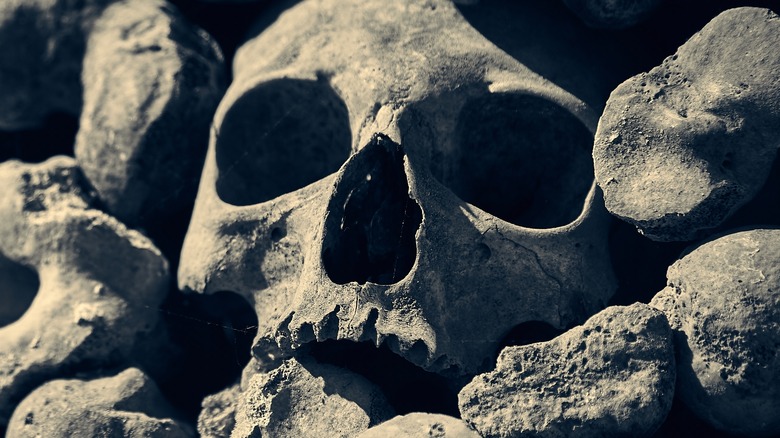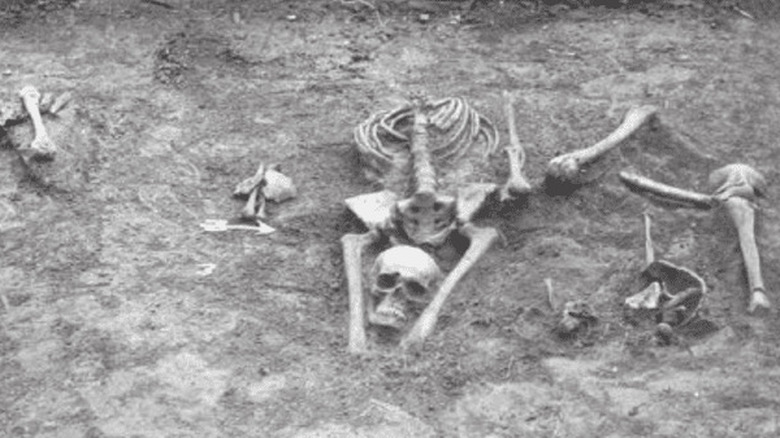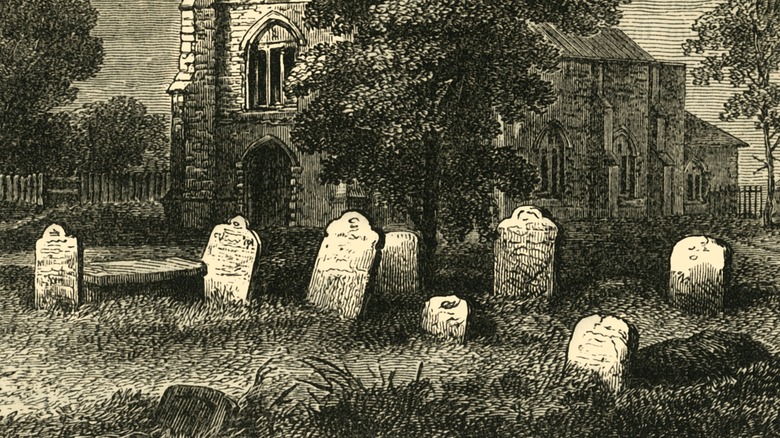One Grave's Chilling Addition Brought Archaeologists To A Supernatural Conclusion
For centuries many cultures have woven folklore into the tapestries of their histories with the long-held notion that the veil that separates our world from the supernatural is thinner than one might realize. After all, there is enough evidence of people's belief in tales of monsters, ghosts, and devils to fill all the world's libraries. However, how do we react when evidence of these beliefs can be found under the very ground on which we walk? In recent years, scores of archaeologists in Eastern Europe have been excavating a slew of burial sites that have elicited some shocking insights about our forefathers' fears of the supernatural and the rituals they performed to ward off the paranormal.
The Washington Post reported in September of 2022 that a graveyard in Pień, a little village in southeast Poland, had yielded the latest in a long line of disturbing discoveries. More than that, it raised some eerie insights and morbid questions about the old superstitions that had gripped 17th-century Eastern Europe with terror.
Can we rely on the people around us to keep us safe? And how do we safeguard ourselves from darker forces when myths merely serve to heighten our fears?
Discovery of an Anti-vampire Burial
According to The Washington Post, a group of researchers from Nicolaus Copernicus University discovered the astonishing skeletal remains of a woman who died in the 17th century. This unidentified woman was discovered buried with a silk scarf (implying she had money), an iron sickle placed over her throat, and a padlock fastened to her foot.
Although unusual, the sickle hints that this woman was accused of being a vampire. According to Dariusz Polinski, one of the key researchers, a sharp scythe like this was ”placed on the neck in such a way that if the deceased had tried to get up, most likely the head would have been cut off or injured” (per The Washington Post). What makes this discovery even more riveting is that it coincides with the discovery of six remains in a cemetery in northwest Poland in 2014. According to the Smithsonian at the time, these six strange skeletons were also buried during the 17th and 18th centuries and exhibit striking similarities.
They, too, had sickles across their necks or bodies, as well as large stones placed beneath their chins, indicating that whoever buried these victims went to great pains to keep them in place. The other bodies in the graveyard, on the other hand, appeared to be quite normal (per Smithsonian).
Sign O' the Times
The New York Post corroborated this discovery in Pień, describing the unmarked woman's tomb as a "vampire graveyard." These anti-vampire burials are the result of a culture of terrified townsfolk who felt the dead would return to exact their vengeance on their communities. As a result, several methods were implemented in order to mutilate or prevent the corpse from rising from the cold, hard ground. According to Live Science, vampires were not only buried with a sickle and a mouthful of rocks, but they were also occasionally buried face down, or in extreme circumstances, impaled, burned, or beheaded.
Anthropologists have identified other surprising traditional vampire repellent methods, such as scattering poppy or mustard seeds around the grave. Locals thought that by sprinkling poppy seeds inside the grave, the vampire would be too preoccupied with counting them and forget to venture out until the sun rose again.
It should be noted that these vampire graves are not just found in Poland, but also in the Balkan countries. Bulgaria, for example, contains around 100 comparable vampire burial sites dating back to the 11th century (per BBC). While we may never learn who the woman recently discovered was, her discovery provokes more questions than answers. For instance, why would anyone fall for the vampire mania? What was the climate like at the time that fostered such otherworldly fears?
Vampire Panic Across Eastern Europe
To appreciate what life was like for our easily frightened forefathers, we must first understand why vampires were feared for centuries throughout Europe. While it's easy to imagine someone cartoonishly nasty like Vlad the Impaler, Dracula, or even Nosferatu, the chilling reality for many was that vampires could have been anyone you encountered. As easy as it is to imagine a bunch of townspeople ganging up on an unsuspecting stranger and burying them, there were plenty of times when people feared members of their communities, or even family members (per Insider). One infamous story involves Jure Grando, a Croatian vampire who purportedly resurrected from the grave to terrorize his old town.
Given our power of hindsight, it's fascinating to consider the historical connections between vampire panics and public health emergencies. After all, how could communities that lacked the scientific knowledge that we take for granted today fathom how their families, and eventually neighbors, were getting sick and becoming unrecognizable in front of their eyes?
While beliefs about the links between blood, disease, and death have existed for millennia, it's intriguing to see how vampire fears seemed to peak at a time when plagues like cholera, tuberculosis, and rabies were also spreading and devastating Europe. Scientific American makes an illuminating link between rabies and the feral aggression that was the vampire's trademark. They also point to the moral fear of losing your humanity and succumbing to a soulless animal nature — a fear that terrified many European peasants and fed right into their folklore traditions.



